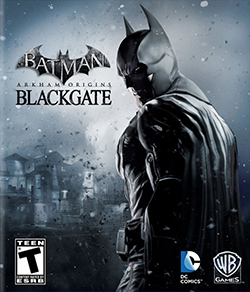| Batman: Arkham Origins Blackgate | |
|---|---|
 | |
| Developer | Armature Studio |
| Publisher | Warner Bros. Interactive Entertainment |
| Director | Mark Pacini |
| Producers |
|
| Programmer | Jack Mathews |
| Artist | Todd Keller [1] |
| Writer | Adam Beechen [2] |
| Composer | Christopher Drake |
| Series | Batman: Arkham |
| Engine | Bluepoint Engine |
| Platforms | |
| Release | |
| Genres | Action-adventure, Metroidvania [3] |
| Mode | Single-player |
Batman: Arkham Origins Blackgate is a 2013 action-adventure game developed by Armature Studio and published by Warner Bros. Interactive Entertainment. Based on the DC Comics superhero Batman, it is a companion game and sequel to Batman: Arkham Origins (2013), and part of the Batman: Arkham series. Set three months after Arkham Origins, the game follows Batman as he attempts to stop a prison riot at the Blackgate Penitentiary, which has been taken over by three of Gotham City's most notorious crime bosses: the Joker, the Penguin, and Black Mask. The story also depicts Batman's first encounter with Catwoman, who aids Batman throughout the game with ulterior motives.
Contents
The game was released on October 25, 2013 for the Nintendo 3DS and PlayStation Vita handheld game consoles, to coincide with Arkham Origins's release for home consoles and Microsoft Windows. [4] The 3DS version was delayed to November 8, 2013 in Europe. [5] In Japan, the game was released on December 5, 2013, the same date as Arkham Origins for home consoles, exclusively for the PlayStation Vita. [6] A deluxe edition of the game was announced and released for Windows, the Wii U eShop, PlayStation Network, and Xbox Live Arcade on April 1, 2014 in North America and April 2, 2014 in Europe. [7] It features new maps, enemy encounters, difficulty levels, batsuits, and enhanced visuals compared to the original. [8]
Origins Blackgate received mixed reviews; it was praised for successfully transitioning the Arkham games to handheld consoles, but was criticized for its setting, navigation system, controls, inconsistent difficulty, and fixed 2.5D camera. An animated sequel, Batman: Assault on Arkham , was released in July 2014, while a direct video game continuation, Batman: Arkham Shadow , was released in October 2024 for the Meta Quest 3.
